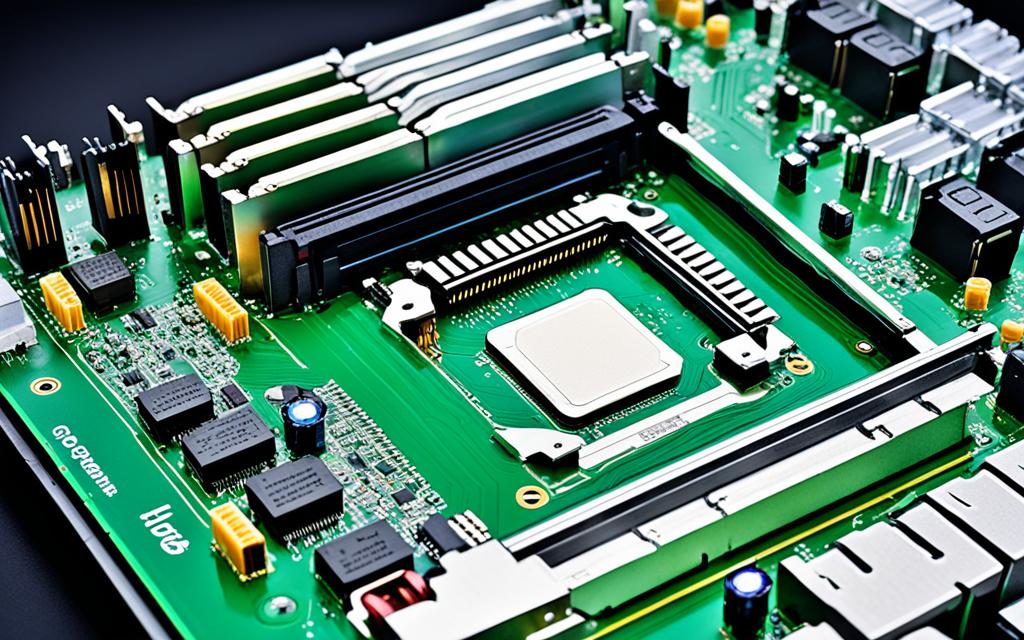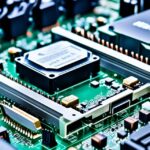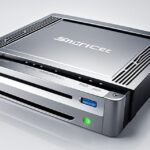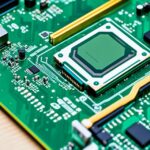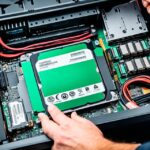Table of Contents
Installing a Hard Disk Drive (HDD) improves your computer’s storage more than external options. This guide explains connecting an HDD to your motherboard. From mounting the drive to getting it recognised in the BIOS, we cover it all. Your system’s performance and capacity will greatly benefit from this installation.
It’s important to note the differences between HDDs and solid-state drives (SSDs). While SSDs are faster, they have a higher cost and less storage. Picking the right HDD can not only increase your storage but also enhance your computing experience. Check out this detailed HDD installation guide for more info.
Key Takeaways
- Understand the differences between HDDs and SSDs to choose the right option for your needs.
- Gather essential tools including a Philips Head screwdriver and SATA cables before beginning the install.
- Ensure your computer is shut down and unplugged to avoid any electrical hazards during installation.
- Always check BIOS/UEFI settings to confirm that your new HDD is recognised by your system.
- Familiarise yourself with your computer case to effectively locate the HDD mounting area.
Understanding HDD and Motherboard Compatibility
When adding a hard drive to a PC, it’s crucial to know how it fits with your motherboard. There are two main types of hard drives: HDD and SSD. Both types offer different benefits for performance and use.
Types of Hard Drives: HDD vs. SSD
HDDs, or hard disk drives, offer a lot of storage at a low cost. They have moving parts and can hold a lot of data, making them great for those who need space on a budget. On the other hand, SSDs use flash memory and are faster and quieter. They’re more expensive but reliable, so you have to weigh cost against speed and reliability.
Choosing the Right HDD for Your System
Choosing an HDD involves looking at several key factors. Make sure the hard drive fits with your motherboard. Most PCs use SATA ports2 to connect HDDs. You also need to think about size: desktops usually use 3.5-inch drives, while laptops prefer 2.5-inch. The speed of the drive, measured in RPM, also matters for how fast it can move data.
Top HDDs like the Seagate BarraCuda and WD Black provide great storage solutions. Companies offer installation guides3 to help you add more storage to your PC smoothly.
| Feature | HDD | SSD |
|---|---|---|
| Storage Capacity | Up to several TBs | Typically less than HDD, but increasing |
| Speed | Slower (e.g., 150 MB/s) | Faster (e.g., 500 MB/s or more) |
| Price | Lower per GB | Higher per GB UserAvatarOutline |
| Noisy Operation | Yes (mechanical parts) | No (no moving parts) |
Knowing these differences helps ensure your storage solution works well and lasts long. Upgrading your PC starts with the right choices.
For HDD choices, think about motherboard fit and what specs meet your needs3.
Essential Tools and Precautions
When you’re installing an HDD, having the right tools and following safety steps is key. Good tools for HDD installation make the process easier and better. It’s important to be ready and safe.
Tools You Will Need for the Installation
For a smooth installation, here are the computer installation tools you’ll need:
- A Phillips screwdriver to secure the hard drive in its case.
- SATA cables for connecting the drive to the motherboard. They’re usually flat, red, and have 7-pin connectors.
- A Molex-to-SATA adapter if you have an older power supply.
- Four 6-32 UNC drive mounting screws to hold the HDD in place firmly.
Before starting, create a tidy workspace to avoid losing any small parts. These parts are often vital for putting things together. Also, remember, SATA drives are common in modern computers. Desktop computers usually use 3.5-inch drives4. It’s crucial to match the notches in the SATA data cable with the keys during connection5.
Importance of Grounding Yourself During Installation
Grounding is critical to keep your computer safe from static electricity. You can use an anti-static wrist strap or touch metal to ground yourself. Make sure to turn off your computer’s power before beginning. When handling Serial ATA drives, be careful to hold them by the edges. This prevents damage to the sensitive parts6.
Correct grounding and installation methods protect your hardware. This leads to a successful upgrade. For more info on increasing your computer’s storage, check out this useful guide.
Preparing Your Computer for HDD Installation
Before you start installing a new hard drive, make sure your computer is ready. You’ll need to follow a few key steps to safely handle your computer. Doing so avoids problems during installation. This ensures a smooth and trouble-free process.
Shutting Down and Unplugging Your Computer
Begin by turning off your computer and unplugging it from the power outlet. This step is crucial for your safety while working inside the computer. After unplugging, press the power button to get rid of any leftover electricity. This step helps prevent electric shocks, making your workspace safer.
Removing the Computer Case
Next, with your computer unplugged, it’s time to open up the case. Use a Phillips screwdriver to take out the screws of the side panel. Keep the screws in a safe spot so you won’t lose them. Removing the panel gives you access to the inside of your computer. This lets you install the HDD easily. Be careful with the components inside to ensure a successful upgrade.
How to Connect an HDD to a Motherboard
Begin by looking for the drive bays at the lower front of your computer case. Hard drives usually fit in a 3.5-inch bay. Your case might also have space for 2.5-inch drives. Make sure you have mounting screws and a Phillips-head screwdriver.
Checking the HDD’s orientation helps with airflow and cooling.
Identifying the Drive Bays and Screw Points
Find the right drive bays and use the correct screws to secure the HDD. Most need four screws. If your case uses a tool-less system, still use screws for a stronger fit. Check if your system uses IDE connections to avoid installation issues.
Mounting the HDD Securely in Place
Make sure your motherboard is compatible, then place the HDD in its slot. Connect the SATA cable to the HDD and motherboard. The SATA ports are often on the bottom-right.
Ensure the connections click in place to avoid problems. This starts connecting the HDD to the motherboard. For help with BIOS issues, see this guide7.
FAQ
What is the difference between an HDD and an SSD?
HDDs are traditional drives that make use of spinning disks. They are cheaper but offer lots of storage. SSDs are newer and use flash memory. They work faster, are quieter, and more reliable but are pricier.
How do I choose the right HDD for my computer?
Pick an HDD by looking at its size and speed. Desktops usually need a 3.5-inch drive. Laptops use a 2.5-inch drive. The speed is in RPM. Brands like Seagate BarraCuda and WD Black offer various sizes for your needs.
What tools do I need to install an HDD?
You’ll need a Phillips screwdriver and SATA cables for the job. If your power supply is old, you might need a Molex-to-SATA adapter. Make sure your workspace is clean and organised.
Why is grounding important during HDD installation?
Grounding yourself prevents damage from static electricity. You can wear an anti-static wrist strap. Or, you could touch a metal surface now and then to stay safe.
What steps should I follow to prepare my computer for HDD installation?
First, turn off your computer and unplug it. Then press the power button to get rid of any leftover electricity. Open your computer by unscrewing it with a Phillips screwdriver.
How do I mount the HDD inside my computer?
Look for the drive bays at the bottom front of your case. Secure your HDD there with screws, leaving room for airflow. While some cases have tool-less mounts, screwing it in is safer.
Source Links
- https://beebom.com/how-install-hard-drive-desktop-pc/ – How to Install Hard Drive (HDD) in Your Desktop PC
- https://www.ufsexplorer.com/articles/how-to/connect-sata-disks-instruction/ – How to attach SATA drives to a computer
- https://faculty.etsu.edu/tarnoff/labs2150/harddrvs/drive_interfaces.htm – CSCI 2150 — Hard Drive Interfaces and Physical Installation
- https://www.wikihow.com/Install-a-Hard-Drive – 3 Easy Ways to Install a Hard Drive: Guide (With Pictures)
- https://www.ufsexplorer.com/articles/how-to/connect-sata-disks-video/ – Connecting SATA drives to a computer for data recovery
- https://www.seagate.com/support/kb/how-to-install-and-troubleshoot-serial-ata-sata-hard-drives-196169en/ – How To Install and Troubleshoot Serial ATA (SATA) Hard Drives | Support Seagate US
- https://www.fiercepc.co.uk/blog/guides/extra-hdd – How to add an extra hard drive to your PC

